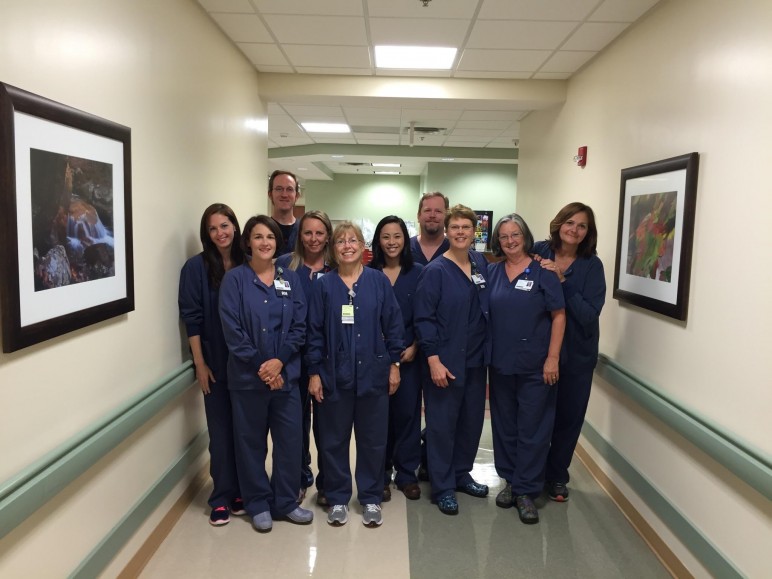In part one of our profile of Sentara Rockingham Memorial Hospital's cardiac team, we discussed how team members stepped up to to continue activating STEMI from the field and reduce the rate of false calls by educating local EMS. In this post, we'll look at Sentara RMH as an example of excellent cath lab team building from a management perspective.
How do you go about cath lab team building? You could start by getting the team out of the lab, as cardiac operations manager Linwood Williams argues.
Getting the cardiac team out of the lab
Williams believes that initiatives like educating local EMS are important for the cardiac team. "They deserve to be able to get out," said Williams. "By giving them avenues, they feel like they're not just in a lab scrubbing cases."
These "avenues" translate into a "shaking up of the status quo" and a team that has ownership over the lab, according to Williams.
Williams also takes steps to improve local networking and the sharing of ideas---starting an ACVP chapter, for example, which has connected cardiac care teams in three regional hospitals for education and discussion.
Getting his team to these meetings and to other hospitals is important for Williams. "If nothing else, it gives a different avenue of thinking, and it gives the staff satisfaction," he said. "Everybody here is really an owner of this lab, and everybody feels they make a difference. I want them to feel that way."
Everyone is a safety champion
Cath lab team building at Sentara RMH means ownership, and that begins with owning patient safety. "They are all very aware of safety," said Williams of his team. "That is an expectation I have of everyone who works here."
Williams asks his team to step up when they see anything that might cause a problem in terms of patient safety, another way the team takes ownership of the lab.
"Everybody really takes it on themselves," said Williams. "If they see a problem they take action to fix it."
Sometimes being a safety champion means standing up to the cardiologist, as one RN at Sentara RMH did by asking the cardiologist if he was sure his decisions were the right ones.
"Instead of the physician getting angry, he complimented her," said Williams. "She was recognized as a safety champion for taking that stance, and all of them do that."
His team is also involved in hospital and local leadership. "They sit on hospital committees and magnet committees, they are out in the community, they are training local x-ray students," said Williams. "None of them just work here, they all own a piece of this lab."
Cath lab team building without cliques
You can almost hear Williams glowing when he describes how well his team supports one another. "They work long days, but they would rather keep working than stop for a half hour break, and they take care of each other," he said.
In many cases, said Williams, "When you have a lot of people together you get cliques and a social group that runs everything."
But at Sentara RMH, the team is more like a family. "I really don't have that here---that's the nicest thing about it," said Williams. "There are no cliques here---they look after each other like a family and like friends should."
Even the cardiologists are part of the culture. "The doctors are very much advocates of the staff," said Williams. "They want to take care of the team as much as I do."
That makes Williams's job a bit easier, but his role is to take care of the staff. "I'm proud of this group," he said. "I work hard to take care of them. I provide patient care by taking care of them, so they can take care of patients."
Hiring with a team focus
How does Sentara RMH approach cath lab team building? It starts with hiring. "We pass up experience if they aren't going to fit in with the team," said Williams.
His view? "I can train someone to be a tech---I can't train you not to be a jerk," said Williams.
Team specs
Perhaps clearly defined roles also play a part in their cath lab team building.
In the Cath Lab division, Sentara RMH employs 12 RNs and 5 techs from different disciplines---Respiratory/RCIS, RCIS, RT-CVT, and RTs with on-the-job training.
Williams ensures that RNs are circulating during procedures. "They all have a ton of experience in cardiac emergency meds and exceptional decision-making skills," he said. "That's the strength of the RN."
With his staffing structure, there is always an RN in the procedure room, and usually two---an RN or Tech sits at the monitor. "Most of the time, that's an RN in our lab, because we have more RNs than Techs for the STEMI process," said Williams.
But Williams also ensures that his Techs scrub every case. "My Techs---Rad Techs, RCIS Techs and Respiratory---they are the ones working the x-ray equipment, in charge of getting the best pictures with the least exposure," he said.
Williams believes firmly in the benefits of specialization and team-based care. "There are many models of a Cath Lab team---some with all RCIS," he said. "But I believe in having the specialists that are really good at a role doing that role."
"I wouldn't have Brett Favre playing middle linebacker," said Williams.
Do you agree with Linwood? Leave a comment below!
The Alliance of Cardiovascular Professionals would like to thank Linwood for taking an active role in sharing and starting discussion on our social media, and allowing us to profile his excellent cardiac team!
Remember to FOLLOW @alliancecvpros on Twitter, LIKE ACVP on Facebook, or leave comments here to join the discussion! You can also subscribe to the blog via email with the option on the sidebar.



Sounds like a great place to work! I am curious about the number of RN’s compared to techs, is there a particular thought process behind that? Do the RN’s and techs’ have a strict division of their role in the cath lab?
The invasive team is composed of 3 techs and 8 RNs. This mix is due to the call rotation and my preference of having two RNs on the call team. I strongly believe that the assessment skills that the RNs bring to the table, along with their critical care experience are one of the reasons that we have such a low mortality rate with our stemi patients.
Job roles are pretty well defined. RNs circulate all of the cases and the techs scrub all the cases. The monitor position can be either, but numbers normally dictate an RN sitting in the captain’s chair.
What is your stemi mortality rate if I may ask?
We have an O/E ratio of .45 for stemi patients. That is against a national score of 1.06.